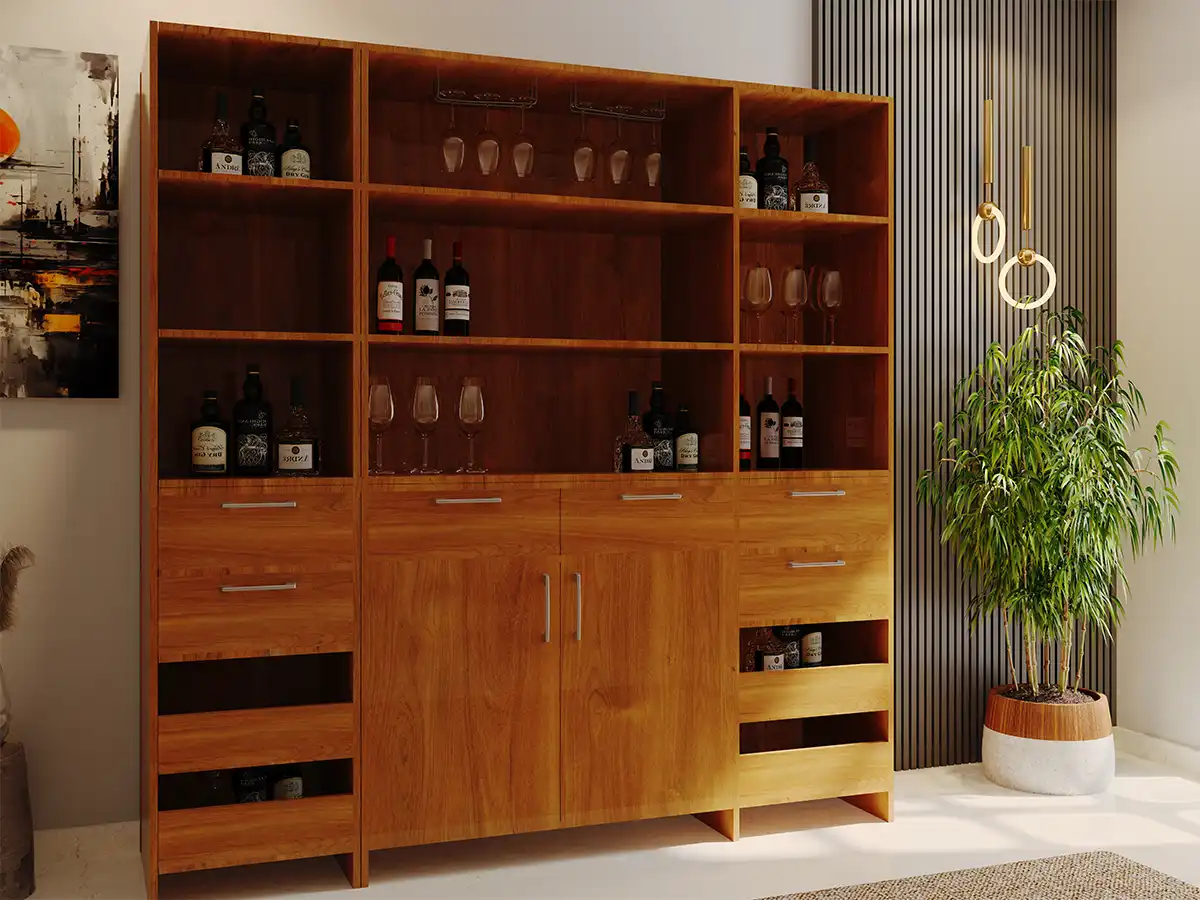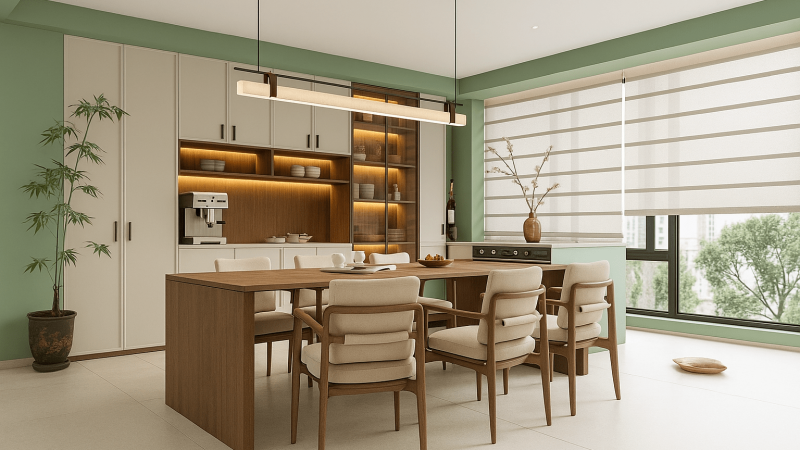Modern Crockery Unit Design Ideas to Transform Your Dining Space

In today’s homes, crockery units have evolved into sleek, stylish, and highly functional storage systems. Let’s explore how to create a modern crockery unit design that perfectly complements your home décor and lifestyle.
What Is a Modern Crockery Unit Design?
A modern crockery unit design is a specially crafted furniture piece that stores and showcases crockery, glassware, and decorative items in an organized way. Unlike traditional bulky cabinets, modern units emphasize clean lines, smart storage, and aesthetic appeal.
These units often combine materials like glass, engineered wood, and metal to create a balanced look that matches contemporary interiors. Some are wall-mounted for space-saving efficiency, while others are freestanding statement pieces that command attention.
Why Every Home Needs a Modern Crockery Unit
A modern crockery unit offers much more than storage. It brings style, structure, and sophistication to your dining or living space.
Here’s why it’s worth investing in one:
-
Adds elegance: A well-designed unit enhances the visual appeal of your space.
-
Organizes your tableware: Keeps crockery, cutlery, and glasses neatly arranged.
-
Saves space: Modular designs and wall-mounted options optimize small spaces.
-
Protects delicate items: Closed cabinets keep dust and damage away.
-
Showcases collections: Perfect for displaying fine china and glassware.
In essence, a modern crockery unit makes your space look polished and purposeful.
Key Features of a Modern Crockery Unit Design
When choosing a modern crockery unit, focus on features that combine beauty and practicality.
1. Sleek Design Aesthetics
Modern units typically feature minimalistic lines and neutral colors such as white, beige, grey, or black. These tones help create a sophisticated, clutter-free environment.
2. Smart Storage Options
Look for a mix of open shelves for display and closed compartments for storage. Soft-close drawers, adjustable shelves, and hidden handles enhance convenience.
3. Lighting Integration
In-built LED lights elevate the look of your crockery display and add ambiance. Warm lighting complements wood tones, while white lighting suits glass or metal finishes.
4. Durable Materials
Choose materials that suit your style and budget:
-
Glass: Offers a luxurious, transparent look.
-
Engineered Wood: Affordable and customizable.
-
Metal: Ideal for an industrial-chic vibe.
-
Solid Wood: Timeless and durable for classic interiors.
5. Modular Flexibility
A modular crockery unit design can be customized to fit wall dimensions and storage requirements, making it ideal for modern homes.
Popular Modern Crockery Unit Design Styles
Different homes demand different aesthetics. Here are the most popular modern crockery unit design styles you can explore.
1. Wall-Mounted Crockery Units
These are perfect for compact homes or apartments. Mounted directly onto the wall, they free up floor space and create a floating effect.
-
Use glass-front cabinets for display.
-
Combine wood and metal for a mixed-material effect.
-
Add under-cabinet lighting for visual depth.
2. Glass Crockery Units
If you love displaying elegant dinnerware or crystal, glass crockery units bring a touch of luxury.
-
Choose tempered glass for durability.
-
Add interior lighting for an upscale effect.
-
Pair with wooden frames to create contrast.
3. Wooden Crockery Units
Wood never goes out of style. A wooden crockery unit design adds warmth and sophistication to any modern dining area.
-
Opt for teak, oak, or walnut finishes.
-
Choose a matte finish for a contemporary look.
-
Match it with your dining table for design harmony.
4. Built-In Crockery Units
For a seamless look, built-in designs merge with your wall or cabinetry. These are ideal for modern homes seeking minimalism.
-
Perfectly aligns with existing furniture.
-
Can serve as a room divider between the dining and living zones.
-
Ideal for customized lighting and design integration.
5. Corner Crockery Units
If you want to make the most of limited space, a corner crockery unit design utilizes often-overlooked areas efficiently.
-
Works beautifully in small or oddly shaped rooms.
-
Can be curved or L-shaped.
-
Use mirrors or glass to add brightness and depth.
How to Style a Modern Crockery Unit
Designing a modern crockery unit is just the start — styling it well makes all the difference.
Tips to Style Your Crockery Unit:
-
Organize by type or color: Keep similar items together for visual order.
-
Mix functionality with décor: Combine crockery with decorative elements like plants, candles, or small art pieces.
-
Maintain balance: Avoid overcrowding shelves; allow space for each piece to stand out.
-
Use lighting smartly: Backlighting or spotlighting draws attention to key areas.
-
Incorporate texture: Mix matte, glossy, and reflective finishes for depth.
A well-styled crockery unit transforms into a design statement that reflects your personality.
Placement Ideas for Modern Crockery Units
The location of your crockery unit impacts both function and aesthetics. Consider these smart placement options:
-
Dining Room Wall: Keeps dinnerware within reach during meals.
-
Living Room Corner: Great for open-plan homes.
-
Between Dining and Kitchen: Perfect transition space for functionality.
-
Hallway or Niche: Adds style without consuming extra space.
Pro Tip: Avoid placing your crockery unit in direct sunlight to prevent fading or heat damage to stored items.
Maintenance Tips to Keep Your Crockery Unit Looking New
To ensure longevity and maintain the beauty of your modern crockery unit, follow these simple steps:
-
Clean glass panels regularly with a soft microfiber cloth.
-
Avoid harsh cleaners on wooden surfaces.
-
Use organizers or trays to prevent scratches on shelves.
-
Declutter once a month to keep it visually appealing.
-
Check lighting and replace bulbs as needed.
Proper maintenance keeps your crockery unit functional and elegant year after year.
How to Choose the Right Modern Crockery Unit Design for Your Home
Selecting the perfect design requires balancing your storage needs with your aesthetic preferences.
Consider these key factors:
-
Space: Measure your available area accurately.
-
Functionality: Decide between open display or concealed storage.
-
Material: Choose one that complements your interiors.
-
Color Palette: Stick to neutral shades or match existing décor.
-
Budget: Opt for modular designs if you need flexibility within budget.
Taking the time to plan ensures your crockery unit feels like a natural part of your home.
Also Read:
Transform Your Space: Living Room Unique Partition Design Ideas That Inspire
Final Thoughts
A modern crockery unit design is more than just furniture — it’s a style statement that combines practicality with beauty. Whether you prefer sleek glass panels, rustic wood finishes, or compact modular systems, the right design will not only organize your dinnerware but also enhance your space’s overall look and feel.
So, when choosing your crockery unit, focus on timeless design, smart storage, and elegant finishes. The perfect crockery unit is the one that reflects your lifestyle and elevates your dining experience.
Looking to give your dining area a modern upgrade? Explore trending modern crockery unit designs today and create a stylish, clutter-free space that truly stands out.

